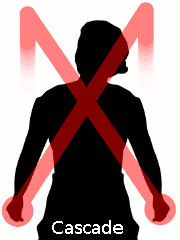How to Juggle 3 Balls

Step 1: One Ball
Start with a single ball; throwing it from hand to hand in an “X” path, so that it peaks about a foot above each shoulder. Focus your vision on two imaginary points on either side which represent the highest point in the balls trajectory. Once you can throw a single ball from hand to hand 10 times in a row, you are ready to move on to two balls.
Step 2: Two Balls
Hold one ball in each hand. Throw the first ball; when it reaches it's peak, throw the second ball so that it crosses under the first ball. At first, don't worry about catching either ball, just let them fall to the ground. Once you are comfortable with the throws, try to make the catches. Practice throwing right/left, and left/right so that you can do both equally well. Once you can throw and catch with two balls ten times in a row, you are ready to try three balls.
Step 3: Three Balls
Start with one ball in your dominant hand and two balls in your subordinate (non-dominant) hand. Throw the first ball (from the hand that's holding two); when it reaches it's peak, throw the second ball (from the opposite hand, just like you practiced in step 2); when the second ball reaches it's peak, throw the third ball. At first, just make the throws and let the balls hit the ground. Once you are comfortable with the throws, try to make the catches. Soon you will be able to throw and catch all
three balls. Congratulations!! you juggled three balls for one cycle!
Beyond the Cycle
To continue the pattern indefinitely, you just keep throwing another ball when the one before it reaches it's peak. Start by making four throws and stop, then five throws and stop, etc. In short order, you will be able to maintain the pattern as long as you want!
If you would like to book Sam Hartford to teach a customized juggling workshop, you can contact him here.
Start with a single ball; throwing it from hand to hand in an “X” path, so that it peaks about a foot above each shoulder. Focus your vision on two imaginary points on either side which represent the highest point in the balls trajectory. Once you can throw a single ball from hand to hand 10 times in a row, you are ready to move on to two balls.
Step 2: Two Balls
Hold one ball in each hand. Throw the first ball; when it reaches it's peak, throw the second ball so that it crosses under the first ball. At first, don't worry about catching either ball, just let them fall to the ground. Once you are comfortable with the throws, try to make the catches. Practice throwing right/left, and left/right so that you can do both equally well. Once you can throw and catch with two balls ten times in a row, you are ready to try three balls.
Step 3: Three Balls
Start with one ball in your dominant hand and two balls in your subordinate (non-dominant) hand. Throw the first ball (from the hand that's holding two); when it reaches it's peak, throw the second ball (from the opposite hand, just like you practiced in step 2); when the second ball reaches it's peak, throw the third ball. At first, just make the throws and let the balls hit the ground. Once you are comfortable with the throws, try to make the catches. Soon you will be able to throw and catch all
three balls. Congratulations!! you juggled three balls for one cycle!
Beyond the Cycle
To continue the pattern indefinitely, you just keep throwing another ball when the one before it reaches it's peak. Start by making four throws and stop, then five throws and stop, etc. In short order, you will be able to maintain the pattern as long as you want!
If you would like to book Sam Hartford to teach a customized juggling workshop, you can contact him here.

